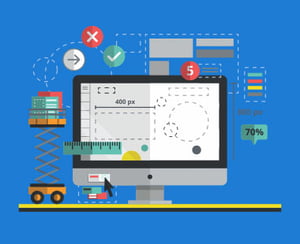 Often the phrase “we need a new website” can strike fear into the heart of home building marketers.
Often the phrase “we need a new website” can strike fear into the heart of home building marketers.
Home builder websites can take months, even years of hard work. And they often run over schedule and over budget. Then, after all the waiting and disappointment, you get to see your expensive new website become stagnant. It may go years without any major functional improvements, since you blew three years worth of marketing budgets already.
There are many reasons why a home builder would need a new website. But just as often, it may be the case that you don't actually need a new site. You just need to breathe life into the one you already have.
A smart approach is to perform a home builder website audit, which takes into account user feedback, website analytics, and industry best practices to identify strengths, weaknesses, and areas for improvement. More about that process here.
So, do you actually need a new website?
Use the following checklist to determine if it's time for a remodel or an all-out teardown.
Signs It’s Time for a New Home Builder Website:
- Your website doesn't have a content management system (CMS). A good CMS gives you or your team to the ability log in and easily update floor plans, communities, homes & models.
Depending on the number of homes and communities you build, you may also need your website to feed to other major listing sites (like Zillow, NewHomeSource, livabl, etc.). Without an automatic feed, you're entering your home listings in multiple places, which is time-intensive, and prone to errors. [> More about improving Builder Data Management here] - You don't have the ability to collect customer contact info. This functionality can be as complex as using an online sales team with full-on marketing automation, to a more simplified manual approach by an Online Sales Counselor. But at a very basic level, your site should have lead generation capabilities. In an ideal world, these leads are sent directly into your Customer Relationship Management (CRM) system for a seamless handoff from marketing to sales. But those solutions can get pricey for smaller builders, in which case a manual entry of a website lead into the CRM works, too.
- It doesn't work well on mobile. We've passed the threshold where more home builder website visitors are now on phones or tablets than desktop computers. Buyers shopping from their mobile devices not only have smaller screens, but they are often looking for different content than people sitting in an office or living room on a laptop. Mobile-friendly is now a must-have for home builders (and a mobile-first home builder website strategy is preferred).
- Your site looks completely outdated. Does your website reflect your brand and speak to your buyer’s tastes? If your site feels like it hasn’t been touched since 1995, buyers may assume your homes haven’t changed since then either. It may be time for a new website.
The High Cost (and Risk) of Unnecessary Redesigns
A complete home builder website design overhaul isn’t just expensive—it’s often an unnecessary drain on time and resources. Depending on the scope, such a project can take anywhere from six months to over a year, with costs climbing into six figures. Yet, despite the investment, many redesigned websites fail to deliver long-term value.
Why? Because budgets are typically exhausted during the initial rebuild, leaving little room for continuous improvements. The result? A stagnant web design for home builders that looks fresh on launch day but quickly becomes outdated as buyer expectations shift and technology advances. Without ongoing updates, even the most beautifully designed site can fall behind, struggling to capture and convert leads effectively.
Strategic, data-driven optimization offers a smarter alternative. Instead of sinking resources into a massive redesign, home builders can implement targeted improvements—enhancing speed, lead generation, and user experience—without starting from scratch. This approach ensures that a website design for homebuilders remains agile, adapting to market trends while maintaining peak performance.
Would you rather invest in long-term results or risk an expensive misstep? The right choice starts with a smarter strategy.
Good news: you might NOT need a new website if...
Your site checks all the boxes above (in a positive way). In this case, what you really need is an agile approach to improving your website. Agile is a method in which you start small, and make a series of improvements, called iterations, based on user feedback. Your end goal may be the same: a beautiful, easily-updated lead-generating machine. But getting there with an agile approach will be much faster and more efficient.
Essential Elements of a High-Converting Home Builder Website
User Experience (UX) Best Practices
A well-optimized home builder website UX isn’t just about aesthetics—it’s about creating an effortless, engaging experience that keeps buyers moving through the sales funnel. Every second a potential customer struggles with a slow, confusing, or unresponsive site is a chance for them to leave and explore other options.
Key UX Factors That Drive Conversions:
- Intuitive Navigation: Buyers need to find information quickly. Clear menus, logical site structure, and a frictionless search function ensure visitors don’t abandon your website out of frustration.
- Mobile Responsiveness: More than half of all users access home builder websites from mobile devices. A responsive web design for home builders ensures that floor plans, pricing, and community details are easy to browse on any screen size.
- High-Quality Visuals: Professional photography, videography, and virtual tours for home builders create an immersive experience that brings properties to life. Buyers expect to explore homes virtually before ever stepping foot inside.
- Website Accessibility: A truly accessible home builder website is designed for all users, including those with disabilities. Features like alt text for images, keyboard-friendly navigation, and proper contrast ratios not only improve usability but also enhance SEO.
Why UX Matters
A study by Google found that 53% of mobile users abandon a site if it takes longer than three seconds to load. Meanwhile, research from Forrester shows that well-designed UX can boost conversion rates by up to 200%. Optimizing web design for home builders with a user-first approach ensures higher engagement, lower bounce rates, and increased lead generation.
Search Engine Optimization (SEO) Integration
A visually stunning website is meaningless if no one can find it. Home builder web design must incorporate SEO best practices to rank well on search engines and attract organic traffic.
Core SEO Strategies for Home Builders
- Keyword Research: Identifying the right search terms ensures content aligns with what buyers are searching for.
- On-Page Optimization: Crafting compelling title tags, meta descriptions, and headings signals relevance to search engines while improving click-through rates.
- Technical SEO: Fast loading speeds, schema markup, and mobile-friendliness contribute to better rankings and a smoother user experience.
- Local SEO: Google Business Profile optimization, location-based keywords, and local backlinks help builders rank in geographic-specific searches.
SEO Impact
Websites ranking on the first page of Google capture 92% of all traffic, while lower-ranking sites struggle for visibility. A home builder SEO strategy that prioritizes organic search ensures a steady stream of qualified leads without relying solely on paid advertising.
Lead Generation and Conversion Optimization
Traffic means nothing without conversions. A high-performing home builder web design should be engineered to capture and nurture leads effectively.
Strategies to Convert Website Visitors into Leads
- Clear Calls to Action (CTAs): Whether it’s “Schedule a Tour” or “Request More Info,” CTAs should be prominent, persuasive, and easy to access.
- Lead Capture Forms: Strategically placed forms help gather visitor information without overwhelming users. Offering incentives like downloadable brochures or exclusive pricing insights increases submission rates.
- CRM Integration: Connecting home builder CRM integration ensures that captured leads flow seamlessly into sales pipelines, allowing for timely follow-ups and nurturing campaigns.
Leveraging Technology for Enhanced User Experience
Emerging tech is reshaping website design for homebuilders, making online experiences more interactive and personalized.
Technologies Transforming Home Builder Websites
- AI-Powered Features: From chatbots answering buyer inquiries to automated content generation, AI-powered home builder websites streamline interactions and improve efficiency.
- Virtual and Augmented Reality: Virtual reality home tours and augmented reality in home building allow buyers to explore properties remotely, increasing engagement and reducing time to purchase.
- Personalized Website Experiences: AI-driven personalization adapts content based on user behavior, displaying relevant communities, pricing, and floor plans tailored to each visitor.
Balancing Technology with Human Oversight
While automation enhances efficiency, human oversight ensures authenticity. AI tools should complement, not replace, the personal touch that builds buyer trust.
Test early and often
Be sure to set up experiments to test the impact of your enhancements. After launching new features, a crucial part of this phase is to take a step back and review the results.
For example, when top 100 home builder True Homes approached us looking for a new website, we checked all the boxes above, and then used an agile approach to come up with an alternative solution to meet the needs of their buyers, one that didn’t involve the pains that go into a redesign. From there, we created a landing page strategy that aligned the goal of the builder (improve ROI of marketing budget) with the goal of the buyer (find a builder that offers the best value) on the very first visit. They saved time and money, and were able to launch, measure and optimize the website campaign in 30 days. To read more about the results, check out this True Success Story.
Optimizing Your Existing Website for Success
A full-scale home builder website redesign might seem like the go-to solution when a site feels outdated or underperforming. However, as we’ve explored, a smarter approach often lies in strategic optimization. By refining home builder web design through targeted improvements—such as UX enhancements, SEO integration, and advanced lead-generation strategies—builders can see significant performance gains without the heavy costs and extended timelines of a total overhaul.
Rather than sinking time and resources into an unnecessary rebuild, focus on ways to maximize home builder website performance with iterative improvements that drive engagement and sales.
![]()
Let’s Talk About Your Website’s Potential
Your website should be working for you—not against you. The Bokka Group specializes in website design for homebuilders that delivers measurable results. Whether your site needs a conversion boost, a UX revamp, or SEO improvements, our team can help you implement a strategy that enhances performance without the hassle of a full redesign.
Get in touch today to discover how to optimize your home builder website for success.
Frequently Asked Questions:
Do I need a new home builder website?
If your current website lacks a content management system, isn’t mobile-friendly, or doesn’t generate leads effectively, it may be time for a redesign. Bokka recommends an agile approach that allows for quick updates and continuous improvements rather than a complete overhaul.
How can a content management system (CMS) improve my home builder website?
A CMS enables easy updates to key content like floor plans, communities, and homes. This reduces the time spent on manual updates and helps ensure your website stays up-to-date and feeds to other listing sites like Zillow or Livabl.
Why is mobile optimization important for a home builder’s website?
With more home shoppers browsing on mobile devices, a mobile-first strategy ensures that your site performs well on any screen size, providing a better user experience and helping you rank higher in search results.
What is the best approach to home builder website redesign?
Bokka recommends an agile approach that focuses on launching a minimum viable product (MVP) with essential features. Continuous improvements are made over time based on user feedback, reducing the need for a large, costly redesign and delivering quicker results.
What features should a modern home builder website include?
Essential features include lead capture forms, CRM integration, responsive design for mobile users, interactive floor plans, virtual tours, and strong calls-to-action (CTAs) to encourage conversions.
How much does a new home builder website typically cost?
The cost of a new home builder website can vary widely based on the complexity, features, and customizations needed. For smaller builders, a basic website with lead generation forms and mobile optimization may range from $5,000 to $15,000. Larger, more feature-rich sites with CRM integration, virtual tours, and advanced SEO capabilities can cost $30,000 or more. Ongoing maintenance and content updates can also add to the long-term costs. It’s important to work with a partner like Bokka who understands your goals to ensure you’re getting the best ROI for your investment.



